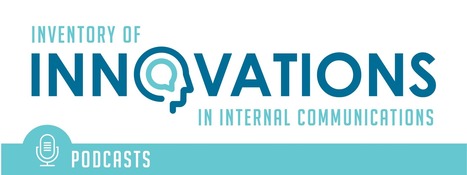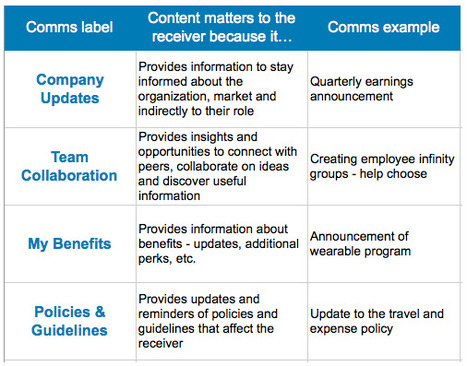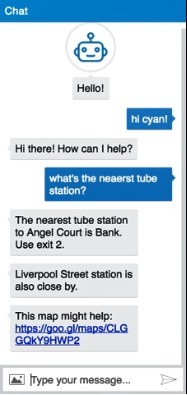 Your new post is loading...
 Your new post is loading...
"What tools do you currently have in your internal communications toolkit? Here are some of the most popular ones other companies will be using in 2020… are they right for you?" Read the full article to find out more about these 15 channels and the pro's and con's of each: - Internal newsletters
- Instant messaging
- Intranet
- Team collaboration tools
- Blogs
- Corporate social media
- Video chat
- Video broadcasts
- Alerting software for important communications
- Team bonding tools
- Surveys
- Forums
- Podcasts
- Screensavers
- Digital signage
"Internal Comms Television (ICTV) is the channel for internal communications and employee engagement programing! Each episode tackles different communications strategies, challenges,
industry changes, thought leadership, and more." Access the page to see the latest videocast episode. Or subscribe to their channel on YouTube.
"Companies have used podcasts for years for broadcasting meetings to a large or global audience, but that’s not the type of podcast I’m thinking about. I’m excited about fresh approaches to podcasts that give leaders and communicators at all levels a chance to reveal a different side of their personalities and what matters to them." Read the full article to find out more about how the following people and organizations are using podcasts: - Chicago Mayor Rahm Emanuel
- Marriott
- Johns Hopkins All Children’s Hospital
"The days of a one-size-fits-all channel are gone. As many as five generations with diverse communication appetites make up today's workforce - making the job of the communicator increasingly complex. Access the article to view the infographic and find out more about the most popular channels being used for internal communication categorized by: - digital
- environmental
- in-person
- print
"Beginning around 2011, content curation was a hot topic. There was no end of workshops and keynotes and blog posts and books. Today, you can talk about curation and hear a pin drop. Curation is alive and well even if it seems quaint compared to Artificial Intelligence, Augmented Reality, voice tech, and some of the other technologies that have pushed it aside." Read the full article to find out more about: - who is curating effectively
- why it should be considered
- new business uses for curated content
"Inspired by The Skimm, Target began reaching out more proactively to its employees with a daily newsletter. Christening the newsletter "Briefly," Dustee Jenkins, SVP of communications at Target, wanted to make sure it was bold, accurate, and that her team would be accountable for the content. "Briefly is meant to be an honest conversation we have every day with our team," said Jenkins. Its content includes information about the retailer’s strategic roadmap, transformation, and even stumbles along the way, mixed in with fun facts about products and pop culture and the occasional positive story about Target or even a competitor. Making sure it lives up to its name, Jenkins’ team made sure the newsletter was no more than a five-minute read, cutting out the "mumbo jumbo" and "corporate speak." Its average read time is 40 seconds. The first Briefly went out to 14,000 staffers on March 23, 2015, and the first-day readership was 81%. Jenkins said that number is still above 80% more than a year later, when it reaches 28,000 staffers."
"Employees need two-way communication to work hard, work smart, and drive business results. Right now, however, it’s common for leadership to lay out goals for the organization with little intel from the people on the ground. Behera said this only perpetuates high-intensity work environments. The resulting pressure cooker culture prompts people to give the perception that they’re working harder, which they are, but they have less time to prioritize and think strategically about what will make an impact. The result is a burnt out worker" Read the full article to find out more about why a two-pronged system of communication can prevent that kind of downward spiral.
"It was last summer that I read an article about a company who declared "Snapchat Day." As a way to force employees to learn more about the app, they could only communicate to other employees through Snapchat. No emails. No phone calls. No messaging. Just Snapchat. The company learned a lot about the app and employee dynamics during the day, but it seeded a thought in my head about whether or not Snapchat could be an effective internal communications channel." Read the full article to find out more about these four reasons that Snapchat could be effective employee communication channel: - Visual
- Mobile
- Employee advocacy
- Storytelling
"Too often, businesses fall into the trap of treating their employees like a captive audience. Because the recipients of their internal messages are on the payroll, they assume their personnel are motivated to read, absorb, and act upon every ponderous Intranet update and boring e-mail that comes their way. The reality isn’t that simple. “Employees are as important as any audience, if not the most important,” said Janet Miller of New Jersey-based Cox Stationers and Printers, which frequently sponsors employee contests and boasts a rooftop beehive at which it holds an annual company-wide honey harvest. “Finding new ways to keep employees interested and engaged is a constant challenge, but a rewarding one.”" Read more to find out why it matters and discover a few ways companies have used creativity to create interesting and effective internal communication campaigns.
"You're doing a disservice to your organization if you don't allow water cooler chat. Focused water cooler chat can help grow your business and build employee relationships. You should encourage it. When you allow employees to interact and converse about non-work-related topics, everyone benefits."
Read the full article to find out more about these 10 reasons to encourage water cooler chat: - It Helps to Build the Company Culture
- It Helps to Bring People Out of Their Shells
- It Provides Casual Facetime with Management
- Water Cooler Chat Leads to Improved Collaboration
- Water Cooler Chat Improves Productivity
- It Promotes a Healthier Staff
- It Creates Great Ideas and Solutions
- It Brings Remote Employees Together
- Water Cooler Chat Works Against Employee Disengagement
- Relaxed Water Cooler Chat Policies Lead to Increased Respect for Management
And also find out more about water cooler etiquette, why it matters, and 8 do's & don'ts to help get you started: - Do discuss interests
- Don't get in the way
- Do ask questions
- Don't create company drama
- Do leave your personal problems at home
- Don't bring up heavy topics
- Do think about ways to improve the workday
- Don't discuss salary or promotions
"Have you launched a new communication program or channel, expecting employees to dive right in, participate and do their part? But they don’t, and you’re left with wondering why. Isn’t this something they needed, maybe even wanted? In fact, employees may simply not know what to do with the information that we have just communicated. If we haven’t let them know our expectations, and made it easy for them to follow, we’re missing a big opportunity."
Read the full article to find out more about using these communication labeling system ideas to clarify expectations, bring greater relevance, and fuel participation with your employees: - Categories: instructional & descriptive
- Mix and match for the ultimate approach
- Customize your labels and categories
"In all the excitement about digital and social media, it’s easy to forget one enduring fact about internal communications. Line managers matter.
Building supervisors into a communications strategy should always be step one; it just doesn’t get talked about much because you don’t need to buy many expensive widgets to make it work. All you need is a bit of common sense and the answers to five basic questions."
Read the full article to find out more about these 5 questions and things to consider about the manager's role in communication: Have we empowered them to communicate? Who’s communicating with them? Have we given them the skills? Have we given them the tools? Is anyone listening?
It’s important to keep everyone informed of progress. How we’re doing, where we are now and where we need to be. But it’s a tough task when there’s so much complex information to share.
It can be difficult to distill what is often decidedly dry details. How do you keep content fresh and appealing? How do you make updates inspiring and engaging? And how do you differentiate your monthly updates from your quarterly reports?
Read the full article to see the infographic and find out more about these 21 tips you can try monthly, quarterly, and annually: - Keep it simple
- Interactive experiences
- Connect the dots
- Look forward
- Mix it up
- Localise messages
- Find the hook
- Offer a handy toolkit
- Simplify
- Share project updates
- Create a short film
- Link with employee performance
- Local focus groups
- Tangible takeaways
- Provide perspective
- Mind your language
- Timing is critical
- Celebrate good performance
- Get creative
- Independent viewpoints
- Infographics
|
Your one stop shop for everything you need to know about effective internal communications for your 2020 communications plan and strategy. Read the full article to discover content on more than 20 IC topics as well as a link to download the free 45 page pdf guide.
Bupa used a chatbot (created by Tangowork) to support employees through the relocation of their London offices. It’s delivered via Skype for Business. After the move, it expanded to questions about day-to-day work “In our new building there are no desk phones. Everything’s done via Skype for Business, and instant messaging is used regularly. So rather than create a website to talk about the new offices, we decided to introduce a chatbot that could offer instant answers.” Read the full article to find out: - how the internal comms team was involved
- what questions the chatbot could answer
- where the chatbot is located
"Today, companies use tools such as Slack, Zoom, Basecamp, Hackpad, Timezone.io to keep communication channels open and active across teams and timezones. And while the software stack for internal communications is impressive, it comes with one huge flaw: it lacks a genuine human connection. This is where Snapchat comes in." Read the full article to find out about Close.io's experience with Snapchat and more about: - How it allows them to build better relationships between each other not only as a team, but also as individuals.
- It removes friction
- It's instant
- It's personal
- It’s (sort of) private
- How they use it
- Keeping each other motivated
- Sending feedback
- Shooting over reminders
- Documenting life on the road
- Documenting customer visits
- Taking founder walks
- Keeping fit
- Where it falls short
- You can’t guarantee employee adoption
- You can’t group snap
"As the business world continues to evolve in unpredictable ways, leaders face new and mounting pressures and challenges. Today’s executives and managers, faced with a constant barrage of information, find it harder than ever to identify the information, tools and resources they require in order to lead. To cut through the clutter, leaders need a fresh communications strategy: a dedicated online community portal." Read the full article to find out more about the value of a user-centric hub: - It saves leaders' time
- It keeps leaders motivated
- It promotes collaboration
- It supports ongoing professional development
"This new tool is a comprehensive community resource created to simplify the science of IC. It captures the essential elements of IC and collates them all in one place to help people strategise, plan, problem-solve and communicate. The Periodic Table of IC began as a simple listing of elements, and things have certainly moved on. Now communicators can dig deeper into each of these elements to discover, research and explore resources."
This article links to and summarizes what you will find on the website Elements of IC. The content is split into the following seven categories containing over 150 elements - all leading to a number of related links, articles, videos, visuals and podcasts from diverse sources: - Strategy
- Objectives
- Themes
- Audiences
- Formats
- Channels
- Metrics
"You and I are probably a lot alike. How, you ask? We both likely have the same daily struggles: striving to gain the attention of our worksite audience and get participants to take action. That challenge got me thinking about a marketing conference I attended last fall. One of the speakers used the phrase “KNOW, BELIEVE, DO” when it comes to engaging your audience and getting people to “Do” what you want them to do. The conference speaker’s ideas have changed the way I approach everything I do now." Read the full article to find out more how these 3 steps can guide your communication and marketing efforts:
"Consistent communication keeps employees from feeling that they're kept in the dark and fed, well, you know. If you think you are already communicating enough to your employees, how do you know that's true? You can determine this by first reviewing the list of techniques below. If you are practicing at least two of the following communication techniques, my experience as a managerial coach tells me that you are headed down the right path of employee communications. Ideally, all of these communication techniques should be used, to increase employee engagement and retention." Read the full article to find out more about these four communication techniques and why they're useful: - Real-time progress updates
- Weekly newsletters to employees
- Monthly 1-1 meetings
- Quarterly 'town halls'
"Kathleen Wolf, Sr Manager of Corporate Reputation & Interactive Media at Whirlpool Corporation, recently joined us on a webinar to discuss how they’ve transformed internal communications. With over 100,000 employees and more than 70 manufacturing and technology research centers throughout the world, Whirlpool was struggling to communicate with their workforce. They previously invested in an intranet, but saw low adoption rates. Once they realized they had reached the maximum capacity of their intranet and weren’t successfully maximizing employees’ potential to tell the brand’s story, they began researching new internal communications platforms." Read the full article to find out why Whirlpool chose a mobile program and: - 3 tips for getting started
- 2 places content comes from
- access to the webinar recording
"How well a message is communicated is as important as the message itself. When it comes to internal communications, this certainly holds true. Company culture can give your organization a major strategic advantage in these changing times. What your culture consists of – goals, values, and practices – must be effectively transmitted for employees to understand and act upon it. Therefore, it’s essential to focus not just on what you’re communicating but also how you’re communicating it." Read the full article to view the infographic and find the link to the detailed guide explaining these 16 best practices for internal communications: - Envision, strategize & plan first
- Use the right tools
- Be visual
- Make it entertaining
- Include metrics whenever possible
- Don’t lose sight of the big picture
- Provide channels for feedback and ideas
- Encourage cross-departmental communication and collaboration
- Avoid communication overload
- Don’t just inform – inspire action
- Open the lines of communication
- Maintain transparency
- Encourage company-related use of social media
- Share industry news, trends and insights
- Use internal communications to recognize and praise success
- Create a customer-centric team with personas
"We're looking to define the building blocks of IC and create an interactive resource for comms pros to jump start discussions and plans, helping to spark ideas and create compelling communications."
Access this page to download the internal communications periodic table created by Chuck Gose and Alive with Ideas. The elements are presented across seven separate sections: - Strategy
- Objectives
- Themes
- Audiences
- Formats
- Channels
- Metrics
"Small- and medium-sized businesses (SMBs) are the largest employers of workers in North America. But how many SMBs do you know with an intranet or even a dedicated internal communications staff?
In reality, many SMBs have very limited resources to communicate with their personnel. Still, they need an internal communications function of some sort because it is critical to employee engagement, which is important because, according to Dale Carnegie Training, engaged employees produce 202 percent more than their disengaged coworkers."
Read the full article to find out more about these low-cost, high impact communications tools of which SMBs can take advantage: - Inside intranets
- Email newsletters and desktop applications
- Mobile applications
- On-demand and streaming video for workshifting staff
Employees want an authentic connection with their leaders. And leaders want inspired employees, engaged in the organization. What if you could have both – and you didn’t have to create more communications, nor even scripted events?
Read the full article to find out more about the successful Gates Foundation Unplugged formula and how you can launch your own unscripted leadership platform using these guidelines: - The anatomy of Unplugged
- Make sure you meet the prerequisites
- Getting started
- Listen and adjust
|



 Your new post is loading...
Your new post is loading...



































There are so many channels to choose from these days. This is a great list of popular channels today. When you understand who your audience is, where they hang out, and how they like to receive their communication, it makes choosing your channel a snap.